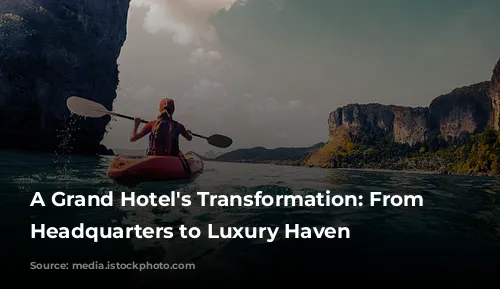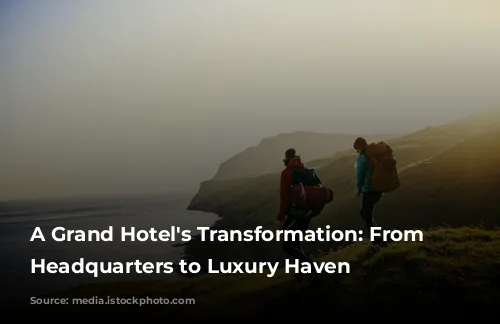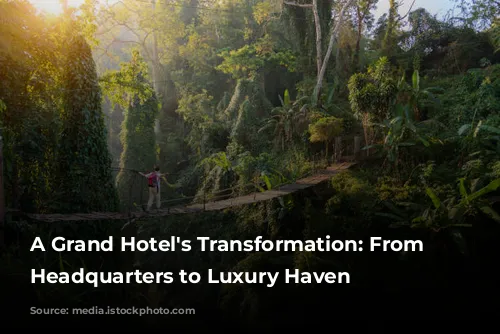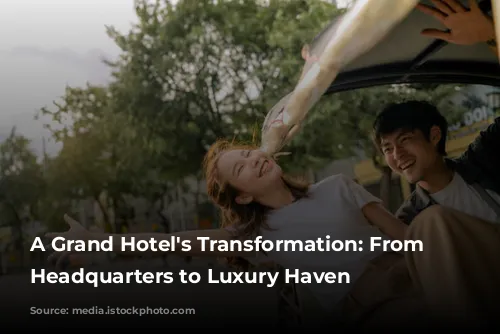The Corinthia Hotel London, perched majestically at the intersection of Northumberland Avenue and Whitehall Place in the heart of London, has a rich history woven into its very fabric. It stands as a testament to the city’s changing landscape, gracefully transitioning from a vital government building to a luxurious hotel.
From Grand Hotel to Government Hub
This imposing edifice, originally known as the Metropole Hotel, opened its doors in 1885. Its prime location, nestled between Trafalgar Square and the Thames Embankment, and its proximity to the Palace of Westminster and Whitehall’s government offices, made it an instant attraction. However, its strategic location also drew it into the fray of two world wars. The hotel was commandeered by the British government during both conflicts, serving as a vital hub for operations. Following the Second World War, the Ministry of Defence acquired the hotel and transformed it into government offices, utilizing it for over half a century.
Rejuvenation as a Luxurious Hotel
In 2007, the Crown Estates deemed the building surplus to requirements and sold it. This marked a turning point for the historical structure as it embarked on a journey of rejuvenation. The hotel was meticulously restored, regaining its former grandeur. It was renamed the Corinthia Hotel, reflecting its dual purpose as both a hotel and a residential complex.

A Gathering Place for the Elite
The Metropole Hotel’s early years were marked by elegance and opulence. It was a favorite haunt of the elite, attracting prominent figures such as the Prince of Wales, later King Edward VII. He even had a reserved box in the hotel’s ballroom and utilized the Royal Suite, thought to be the first-floor rooms with bow-fronted windows overlooking Whitehall Place. The hotel also played host to the Aero Club and the Alpine Club‘s annual dinners, and it served as the starting point for the inaugural London to Brighton run in 1896.

A Stage for Musical Entertainment
The Metropole Hotel also witnessed the rise of musical talent. After the First World War, the hotel gained fame for its captivating “Midnight Follies” cabaret. Bert Firman, a young violinist, seized the opportunity to lead the Midnight Follies Orchestra at the tender age of sixteen, becoming the youngest bandleader in the world. His success was followed by other renowned bandleaders like Mantovani, solidifying the hotel’s reputation as a hub for musical entertainment.

A Witness to Sporting History
Beyond its allure as a social and musical center, the Metropole Hotel was also a witness to a pivotal moment in sports history. On January 4, 1936, the England Rugby Union team triumphed over the touring New Zealand All Blacks, thanks to a legendary performance by Prince Alexander Obolensky. Obolensky’s three tries, particularly his first, which saw him outmaneuver several All Blacks in a remarkable run, solidified his place in rugby lore. The England team celebrated their victory at the Metropole, where they found themselves sharing the venue with their defeated opponents.

A Return to Government Service
In the mid-1930s, the government leased the entire Metropole Hotel for a substantial sum, utilizing it to provide office space for various departments, initially for the Ministry of Labour and the Ministry of Transport. Later, the Air Ministry and the Ministry of Defence took up residence in the hotel. The hotel was once again repurposed for government use, becoming a vital hub for national administration.

A Pivotal Role in World War II
As World War II loomed, the government extended the lease and requisitioned the building once again. The hotel became a vital wartime asset, housing various departments. Notably, room 424 served as the initial home for MI9 and its sub-division, the Special Operations Executive, further solidifying its strategic importance.

A Post-War Transition
Following World War II, the government purchased the hotel from Gordon Hotels and added it to the Crown Estate portfolio. It continued to serve as an overflow building for the Ministry of Defence, with the Air Ministry becoming a major occupant. From the mid-1960s until 1992, the hotel housed the majority of the Defence Intelligence Staff, underscoring its ongoing significance in national security matters.

A New Era of Luxury and Glamour
The Metropole Building, having stood vacant since 2004, underwent a significant transformation in 2007 when it was acquired by a consortium. This marked the hotel’s transition to a new era, one defined by luxury and opulence. The building reopened in 2011 as the Corinthia Hotel, managed by Corinthia Hotels International. This new chapter saw the building’s transformation into a lavish hotel and residential complex, reflecting its status as a symbol of contemporary London.

A Glimpse into Film History
The Corinthia Hotel’s rich history continued to captivate the world when it was chosen as the backdrop for several film productions. The official announcement of the James Bond film “Skyfall” took place at a press conference held at the hotel in 2011. The hotel also played a prominent role in the 2018 thriller “Red Sparrow,” with scenes filmed both inside and outside the building. This enduring link to the film industry solidified the hotel’s position as a landmark of cultural significance.

An Artist’s Haven
The Corinthia Hotel, in a nod to its artistic heritage, initiated the Artist in Residence program in 2011. This initiative allows writers, theatre companies, and filmmakers to showcase their work within the hotel’s grand spaces. Each year, an artist is selected to participate in the program, bringing their unique talents to the hotel’s vibrant cultural landscape.

A Legacy of Transformation
The Corinthia Hotel London stands as a powerful testament to the city’s evolution. From a grand hotel that hosted royalty and elite society to a vital government hub during times of war, it has witnessed the ebb and flow of history. Its transformation into a luxurious hotel and residential complex marks a new chapter in its illustrious story, reflecting its enduring spirit and its ability to adapt to the changing times. As it continues to stand tall on the corner of Northumberland Avenue and Whitehall Place, the Corinthia Hotel embodies London’s dynamism and its timeless elegance.


